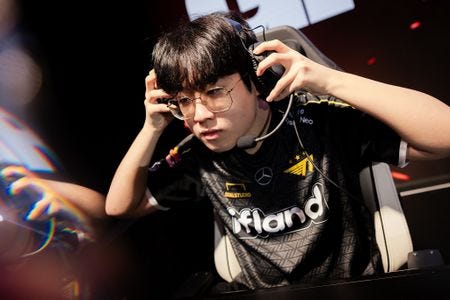Two days to the sold-out Worlds and counting. Tickets are on offer at upwards of eight times face value on resale sites. Forget darts at the Ally Pally - the fancy dress there is simply child’s play by comparison to the cosplay here. We’re talking the 2024 League of Legends World Championships Final at London’s O2. What do you mean, it’s not inked into your diary?
League of Legends (LoL) is the leading ‘multiplayer online battlefield arena’ (MOBA) game in the world. Last year’s World Final in South Korea garnered a peak audience of 6.4 million viewers (plus unknown numbers in China). A global esports record. This year, teams will compete in London for a $2.25 million prize pot. Lest you think this is an overnight sensation, LoL was launched by Riot Games way back in 2009. Don’t be surprised, then, to see hordes of thirty-somethings spewing out of North Greenwich tube station on Saturday - only a minority in elaborate costumes, I’m reliably informed. But many sporting replica team shirts emblazoned with global brand logos.
Already viewed 8.5 million times, watch the Worlds 2024 trailer here
Newzoo, the gaming insight specialists, estimates that there are 3.42 billion gamers globally. That’s just over 40% of the world’s population. Almost half of them pay to play, helping generate revenues of $187.7 billion. Industry growth is currently sluggish, in large part because the total time the average player spends gaming has declined by a quarter since a pandemic peak in early 2021. Then, lockdowns restricted leisure activities. Critically, though, the dominant, long-established games franchises such as LoL have relentlessly gained market share.
All of this matters to traditional sports because in recent years many have had the ambition to harness the appeal of esports - especially for younger generations - to counterbalance their ageing fanbases. Most have dreamed of esport versions of their own ‘real life’ offerings. Football is the only sport, however, to make a genuine success of such an initiative. This has been helped by its immense global presence, EA Sports’ FIFA having a history tracing back to 1993, and many of football’s stars falling in love with the online game.
The International Olympic Committee has flirted with esports as a means of becoming relevant to new generations. It has struggled, though, to decide whether this means embracing the market-leading games or encouraging the development of digital versions of existing Olympic sports.
The Asian Games, part of the Olympic movement, now contain esports medal events, including League of Legends. None of the seven chosen esports for the next edition in Japan in 2026 are clones of conventional sports. By contrast, the inaugural Olympic Esports Games in Saudi Arabia next year will include e-versions of Olympic sports.
It is no surprise that Asia and the Middle East are the focus of the IOC’s esports efforts. Newzoo calculates that 53% of the world's gamers are in Asia. That’s 1.8 billion people. The fastest growing gaming region is the Middle East and Africa, now with 16% of the globe’s gamers. North America musters a surprisingly paltry 7% - until you realise that is still 40% of the region’s population.
While it would be easy to conclude that traditional sports have missed the esports boat, it may be that there was never one to catch in the first place. If it was possible to draw a Venn diagram of sport and esport fans there would doubtless be a substantial overlap. But the same would be true of sport and other forms of entertainment. Each can exist separately in the mind, calendar and spending plans of individuals. Any attempt by one to feed off the other will usually appear artificial and may indeed backfire commercially. Taylor Swift’s boost for the NFL works because it is rooted in authenticity not artifice - or certainly appears so.
The IOC may make a success of its esports initiatives, but my forecast is that this would merely bolster it as an organisation, not have any impact on its core product, the Olympic Games. Meantime, consolidation will continue in gaming, the industry evolving along classic Darwinian lines. This Saturday’s Worlds at the O2 is just one manifestation of the trend, outsized costumes, plastic weapons and all. And as its fanbase ages, so gamers will take over the world.
Worlds 2024 Event Policies (abridged)
You must be recognisable at all times. Your costume must not be wider than 1.2m across, longer than 1.8m, or taller than 2.4m. Additionally, you must be able to easily manoeuvre your costume over stairs or ramps unassisted. You must be able to fit through the walkthrough metal detectors, which are 76cm wide and 203cm tall. Any mask must be removed for the duration of the event, but can be put on for short periods of time for the purpose of taking pictures and interacting with other guests.
You must also be able to sit in your seat while wearing your costume. You must have unobstructed vision at all times. No weapon may be sharp or pointed enough to cut or pierce someone with moderate pressure, or heavy enough to create a threatening club. You may pose with a prop in a brandishing manner, so long as no reasonable person would interpret the pose as anything other than dramatic effect.
Every little helps
Buried under the tens of billions of pounds of tax rises, government debt increases and spending on the NHS in yesterday’s budget was an extra £9 million a year for UK Sport. This equates to a 10% funding uplift over the four year cycle to the LA28 Olympics and Paralympics.
While this is only a partial reversal of the corrosive effect of inflation over the past few years, it is very welcome nonetheless. And much needed, a recent survey of Britain’s athletes highlighting their money worries - concerns shared by most sports governing bodies. I’ll return to this in next week’s Sport inc.
Villains in ticketing teams
An Aston Villa fan wrote ahead of his team’s run of three home matches in three different competitions in nine days to complain about the price of Champions League tickets. Cheapest adult ticket to see Villa v Bologna? £85. Bournemouth in the Premier League in the same section was £44.50. A Carabao Cup game against Palace, unsurprisingly just £25.
Attendances at the first two were 41,847 and 42,165 with the crowd for the Carabao defeat to Palace not yet available. As it’s 42 years since Villa last played in Europe’s top competition I find it hard to argue with its ticketing team’s strategy. Fixed supply, massive demand. Bologna, though, is a less alluring proposition than Villa’s first Euro opposition at home this season, Bayern Munich. The test of the price premium over Premier League fixtures will come if Villa make the Champions League an annual habit and UEFA’s new extended competition throws up less-than-glamorous ties.





